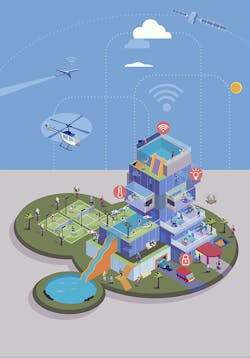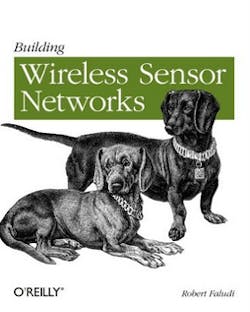Quick! What do the Nest Thermostat, Ralph Lauren Polo Shirts, and Fitbit Motion Trackers have in common?
Here’s a hint: it has to do with the Internet of Things. The answer is:
All three companies managed to take saturated commodity markets and release products with obscene profit margins.
Ask yourself, when is the last time you sold a job at 200% margin? Chances are you’re still struggling to pull in 20% to 40% margins on owner direct, key account, and service work. Therefore the question we pose in this article is, how can you bottle up a little bit of The Internet of Things magic and sprinkle its profit making dust on your projects?
The Internet of Things gives you a new way in which you can impact your customer’s business, whereas, in the past, you were limited to the sensors and devices that were available with your controls offering.
That reminds me of an experience I had recently. I was sitting down watching television with my kids, and a commercial came on trying to sell me on the benefits of subscribing to my cable company’s smart home service. As of late, I’ve noticed more and more companies trying to tap into the “Internet of Things” to transform their industries and services. That got me thinking about what kind of possibilities exist for contractors within our space to create new solutions and deliver value to their clients.
You can imagine it was quite timely that I was asked to write this article about what the Internet of Things means for those in the HVACR contracting space. While brainstorming what exactly I would say, I realized that this was less of a “technology” discussion and more of a process conversation.
You need to be able to use the Internet of Things to impact business outcomes.
Process, you say? How in the world is process going to help you close business in the typical world of low margin, bid-and-spec, relational selling? I will challenge you by saying that process is exactly where the conversation needs to be. The Internet of Things promises to unleash a torrent of devices into the market, but in reality, all those new devices do is provide you with more ways to increase the size of your low margin work. If you're truly going to achieve breakout velocity, then you need to be able to use the Internet of Things to impact business outcomes, and that is what this article is about.
How Can 1 +1 = 3 ?
Do you want to increase your likelihood to win a project? Of course you do, but what are your current options to do that?
Well, you can take the age old strategy of being the low bidder, cut your costs, and hope you make it up on change orders and service work. Or maybe you can go after the relationship route. You can take clients out and hope that after you get them to like you that you don’t get blindsided when the decision maker retires and his or her replacement invites their own friends to the party.
Fortunately for you, the Internet of Things gives you a new way in which you can impact your customer’s business, whereas, in the past, you were limited to the sensors and devices that were available with your controls offering.
The Internet of Things allows you to solve customer problems, improve their processes, and differentiate yourself in a way that adds value.
But before we go any deeper it will help if we pin down what the Internet of Things really is.
After reading multiple definitions for the Internet of Things, I wasn’t able to find one that I felt did the Internet of Things justice. Therefore, I created this definition that I feel really captures the essence of this article.
The Internet of Things is less about the introduction of more widgets, gadgets, and devices. Rather, the Internet of Things is about the connections. From these connections come new processes; some will be more efficient, and some will not. However, with the Internet of Things, the barrier of entry is lowered, and for the first time the average person can create value through connections.
Did you catch the subtle nuances in the last sentence? If not, let me explain. Because of the Internet of Things, the barrier of entry for work in the BAS space is lowered. This means that the average person can create value through the new connections they create. It used to be that you needed a fully funded Research and Development team. That has since changed, because now, with open Application Programing Interfaces (API’s), off-the-shelf solutions, and open systems, if you can dream it, you can create it.
Enough of the Grandiose Talk. What Does this Mean For Me?
If you're thinking that I've been talking in large, undefined concepts, you're correct. The good news is, this was by design. In order to get you to appreciate the gravity of the next several paragraphs I needed to shift your focus off the device and onto the outcome.
The problem is, when I say Internet of Things what do you picture? Do you picture sensors? Devices? Networks? All of those are definitely important, but those are not what makes the Internet of Things valuable to you.
What Does the internet of Things Provide to You?
- The Internet of Things allows you to solve customer problems, improve their processes, and differentiate yourself in a way that adds value.
- The Internet of Things gives you permission to continue doing business with your client long after the installation is completed.
- The Internet of Things opens up other buyers and departments to you.
Contact your building automation provider of choice and discover if they have an Internet of Things Framework and/or Reference Architecture.
In the past, when I needed to validate an environment for a client, I would purchase ridiculously expensive sensors. I would then proceed to place them throughout the building, and after a week I would collect those sensors, tally up the data points, and I would create heat maps to help the client validate the environmental condition of their environment.
With the Internet of Things, I no longer need to install sensors, upload data, and graph values. Using some simple programming, I can literally purchase a series of sensors off-the-shelf, and tie these sensors back via an open protocol like Bluetooth Low Energy (BLE), Zigbee, or Wi-Fi. With the data now captured, I can use some basic programming and open-source visualization software to create a living, breathing, heat-map of low-cost commodity sensors that provides the customer with real-time data.
I can hear some of you saying, “Hold on a minute, you want me to be a programmer? You want me to design networks? You want me to design technology? I thought this was going to open up opportunities not create new work?”
What exactly is an opportunity? Is it a chance to do the same things you’ve done before, or is it a chance to be one of a select few who work differently and end up bringing value to their clients and opening new markets for their companies?
What exactly is an opportunity? Is it a chance to do the same things you’ve done before, or is it a chance to be one of a select few who work differently and end up bringing value to their clients and opening new markets for their companies?
Some of you in the Building Automation Space may remember when we switched from pneumatics to Direct Digital Controls (DDC). Do you know where those folks who didn’t want to learn that “computer stuff” are today? I can say one thing with certainty, they aren’t out selling million dollar contracts. Actually, the few of them that survived are struggling daily to defend their value. I have seen this first hand on jobsite after jobsite.
So How Do I Learn This Stuff?
And therein is the real challenge. The purpose of this article was not to teach you the technical aspects of designing and implementing the Internet of Things. The purpose is to get you to visualize your problems differently. After all, that is what the Internet of Things is really all about.
Does it make sense to buy five hundred flow sensors at $2,000 a sensor? No, of course not, but what if a company in China can make the same sensor for $100 each and you can use a wireless network to connect the sensors and make real-time adjustments to flow, reducing the usage of a central plant by 5 percent? Up until recently, only the major manufacturers could boast about such technology. However, with the lower barrier of entry, if you can dream and procure it, then you can sell it. That my readers, is a recipe for success.
Therefore, your challenge is to look at things differently. How can you combine technologies to produce different outcomes? Can you look outside your traditional box and identify issues that exist, that an interconnected system could solve? The ability to deploy cheap sensors and newer devices is useless if you don’t help your clients realize that they have problems that the traditional solutions cannot solve.
Next Steps in Learning
In this article, I created a compelling case for systems integration, and demonstrated a few ways you can grow your business by thinking differently about the role that technology plays in your projects. Naturally, I would expect that you would want to know a couple next steps to guide you forward. The following are the three steps I recommend you follow in order to grow in your knowledge and capabilities around the internet of things:
Second, I would encourage you to pick up a copy of Building Wireless Sensor Networks: with ZigBee, XBee, Arduino, and Processing, by Robert Faludi. Robert is one of the leading experts around Machine to Machine communication and he has wrote an excellent book around wireless sensor networks. At the end of the day, most of the work you will be doing with the Internet of Things revolves around sensors. Therefore if there was only one book I could recommend it would be Robert’s book. I have no relationship to him or his book at all. I am simply recommending it because it is an amazing write up on sensor technologies.
Third, I am working on a project called The Internet of Things Database. The Internet of Things Database exists to provide an easy to use database of all of the Internet of Things frameworks, open-source projects, standards, and vendors. I update this list weekly and I am gradually adding my own personal reviews of each technology. Click Here to Access The Internet of Things Database.
Finally, I would like to leave you with one parting comment. The Internet of Things is complex, it is a market that has not yet jelled and it is full of companies, frameworks, and ideas. This can be scary for someone who is new to the Internet of Things landscape. My advice to you is to not let this complexity scare you away. While there are hundreds of companies competing for your business in this space, you can narrow them down if you simply know what you want to do. If you follow my steps above, you will be in a good position to further expand your business into the world of the Internet of Things. I look forward to your feedback and responses.
Phil Zito is a Senior Technical Program Manager at a Fortune 100 Company. He is focused on Systems Integration and program management and has 12+ years in the smart building space. The thoughts in this article are based on his experience and do not represent the views of his employer.

